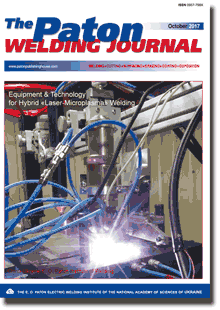| 2017 №10 (02) |
DOI of Article 10.15407/tpwj2017.10.03 |
2017 №10 (04) |

The Paton Welding Journal, 2017, #10, 18-23 pages
Efficiency of process of coating spraying using multichamber detonation unit
O.V. Kolisnichenko1, Yu.N. Tyurin1 and R. Tovbin2
1E.O. Paton Electric Welding Institute of the NAS of Ukraine 11 Kazimir Malevich Str., 03150, Kiev, Ukraine. E-mail: office@paton.kiev.ua
2Sputtek Inc. 1 Goodmark Place, Unit 4, Toronto, Ontario, Canada M9W 6M1
Abstract
A multichamber detonation unit is designed for coating deposition using powder materials. Heating and acceleration of powders is carried out by detonation combustion products of gas mixture of propane, oxygen and air with 20 Hz frequency and more. A difference of multichamber detonation unit is a presence of additional combustion chamber, which rises gas-dynamic parameters of the detonation products and efficiency of spraying process. Effect of unit design peculiarities on gas-dynamic parameters of detonation products was determined. Velocity of detonation products reaches 1520 m/s, detonation wave pressure makes approximately 3.5 MPa. Velocity of the sprayed particles using this unit reaches 1200 m/s. The unit is equipped with a valveless system for gas and powder feeding. This provides reliable operation at high frequency of detonation initiation (up to 50 Hz). A spraying deposition efficiency at that reaches 82 and 67 % for cermet powders and oxide ceramics, respectively. Coatings received at that are characterized with small porosity (< 1 %) and high adhesion to substrate. 13 Ref., 1 Table, 6 Figures.
Keywords: multichamber detonation unit, velocity and pressure of detonation products, spraying deposition efficiency, velocity and extention of powder jet
Received: 18.05.17
Published: 13.11.17
References
- Poorman, R.M., Sargent, H.B., Lamprey, H. (1955) Method and apparatus utilizing detonation waves for spraying and other purposes. US Pat. 2714563.
- Tyurin, Yu.N., Ralf, S.E., Shulzhenko, V.A. et al. (1976) Device for detonation deposition of coatings. USSR author’s cert. 669539 [in Russian].
- Tyurin, Yu.N., Garbuzov, A.P. (1983) Methods of detonation deposition of coatings. USSR author’s cert. 1045491 [in Russian].
- Endo, T., Obayashi, R., Tajiri, T. et al. (2016) Thermal spray using a high-frequency pulse detonation combustor operated in the liquid-purge mode. Therm. Spray Technol., 25(3), 494–508. https://doi.org/10.1007/s11666-015-0354-8
- Gavrilenko, T.P., Nikolaev, Yu.A., Ulyanitsky, V.Yu. (2010) Application of overcompressed detonation of coating deposition. Fizika Goreniya i Vzryva, 46(3), 125–133 [in Russian].
- Prokhorov, E.S. (2011) Approximate calculation of overcompressed gas detonation in converging channels. Vestnik NGU, Ser.: Fizika, 6(2), 5–9 [in Russian].
- Tyurin, Y.N., Pogrebnjak, A.D. (1999) Advances in the development of detonation technologies and equipment for coating deposition. and Coat. Technol., 111(2–3), 269–275. https://doi.org/10.1016/S0257-8972(98)00826-3
- Shtertser, A., Muders, C., Veselov, S. et al. (2012) Computer controlled detonation spraying of WC/Co coatings containing MoS2 solid lubricant. Ibid., 206(23), 4763–4770. https://doi.org/10.1016/j.surfcoat.2012.03.043
- Tyurin, Yu.M., Kolisnichenko, O.V. (2008) Method of detonation spraying of coatings and device for its realization. Pat. 83831, Ukraine [in Russian].
- Khitrin, L.N. (1957) Fizika Goreniya i Vzryva. Moscow, MSU [in Russian].
- Baum, F.A., Stanyukovich, K.P., Shekhter, B.I. (1959) Physics of explosion. Moscow, Fizmatgiz [in Russian].
- Baj Shi-i (1960) Theory of jets. Moscow, Gos. Izd-vo Fiz.-Mat. Lit-ry [in Russian].
- Markashova, L.I., Tyurin, Yu.N., Kolisnichenko, O.V. et al. (2014) Structure-phase condition of wear-resistant composite coatings of Cr3C2–NiCr system, deposited using multi-chamber detonation installation. In: of 7th Int. Conf. on Mathematical Modelling and Information Technologies in Welding and Related Processes (15–19 September 2014, Odessa, Ukraine), 37–42 [in Russian].
